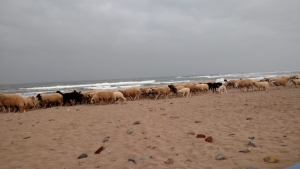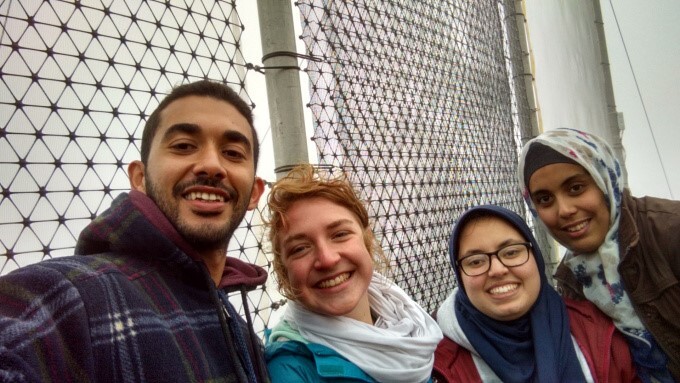
The following post was written by Sophie Nachman.
I didn’t leave my house Sunday. Between making muffins, eating meals, and doing dishes, I spent my day sitting on the terrace writing in my journal. I was too sore to do anything else. The ache in my everywhere was a lovely reminder of the joys of the weekend – a weekend too exciting not to share.
On Thursday, after stopping in the souk for fried fish and tagine, our lovely group set off from the Dar Si Hmad headquarters in Agadir for Sidi Ifni, a small city about three hours south. The group consisted of twelve visiting American university students, two Moroccan university students serving as language partners, some of our fearless leaders at Dar Si Hmad, and me, the tagalong intern. The students and I crowded into a small bus while Jamila, Maisie, and our other leaders took a separate car. After about two hours, we stopped in Tiznit a small city known for its wealth in silver. Within the silver markets, you find old, traditional jewelry mixed with new and cheaper jewelry. The price of your purchases depends on the weight, age, and purity of the silver. There was jewelry everywhere and it was a bit overwhelming, but mostly it was just beautiful. After wandering around for about an hour, we all packed into the bus again to continue our journey to Ifni.
Ifni is a small coastal town in southern Morocco. It is interesting geographically because it is sandwiched between the mountains and the sea. The culture was described to me as a blend of Amazigh, Arab, Old Spanish, and Hippie Tourist. Life is relatively slow paced and easy going. It is by no means a wealthy city although it was once very important strategically for trade during the Spanish protectorate, which lasted in this region from 1934-1958. Some would say that the city fails to improve financially because it is stuck remembering its former glory. Nevertheless, the town is quaint, calm, and friendly.
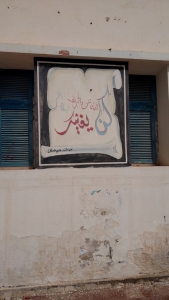
We arrived in Ifni in the evening and took some time to settle into the hotel before walking to the original Dar Si Hmad building for dinner. The hotel was cute and homey in a beach-shack kind of way. The rooms were cozy with a great view. It was right near the beach, and the café downstairs hosted musicians in the evening for some casual jam sessions. After a delicious meal and some lovely music, we all went to bed early, anticipating Friday’s hike.
After 8am breakfast at the hotel, we all packed into the bus for a short ride to the base of the mountain. There had been some concerns that we would not be able to take the hike because of the mud, but we were blessed with good hiking and fog observing weather. The five mile hike up the mountain was beautiful, with pleasant weather and green fields of flowers that eventually gave way to more rocky paths and wind. We took a break about halfway up and the wind was so strong I was slightly worried I might fly off the mountain.

Thank goodness I didn’t, but I finally started to understand how the fog nets work, as I could see the fog whizzing by between me and my friends. By the time we reached the top, you couldn’t see more than a few meters off the path because of the fog. At that point, we were tired and cold so we stopped in the Fog Observatory for a lunch of tea and Loubia, a thick white-bean stea that I love any day but tastes about 100 times better after hiking up a mountain. The Fog Observatory is a small building on the top of the mountain next to the Fog Harvesting Project that serves as a modest work station. A few more meters up, we witnessed fog harvesting in action.
The Fog Harvesting Project is ‘La Fiertée de la Famille’ Dar Si Hmad (in the words of my grandmaman). The principle is actually quite simple; big nets capture fog droplets which collect into water, and can then be stored for use in rural villages without running water. At the moment, DSH is in the process of taking down the old nets and replacing them with new-and-improved nets with studier foundations that will withstand stronger winds and capture more fog.
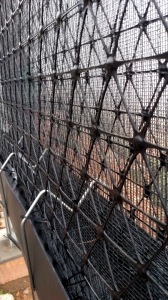
We were therefore able to see both the old and new technology in action. As we appreciated the innovative project in action, we were repeatedly blessed with water that blew off the nets. I couldn’t help thinking of this journey as my baptism into the DSH family.
We huddled in the Fog Observatory for a little more mint tea and to warm our frozen toes before setting off back down the mountain. Five miles later, we crowded back on the bus, tired and stinky, for a short drive to a Qur’anic school nearby.
Boys attending Qur’anic schools start around age 7 by memorizing the Qur’an in its entirety, orally. Then they learn to read and write. Throughout their life, they study under various masters for 6-7 years before moving on to the next master. The master of this school was a master of the 7 recitations of the Qur’an. The students were men approximately age 20-30, who came from all over Morocco to study with this master. It was explained to us that this religious schooling prevents Islamic extremism from taking root in Morocco because of the strength of enlightened Islam.
This particular madrasa [school] has been around since the 11th century, although a new building was recently constructed next to the original Mosque, which was quite small. While we were there, we listened to the students perform Qur’anic chanting. Though I did not understand what was being said, I found it beautiful, and I think it is safe to say that all of us were impressed with the performance.
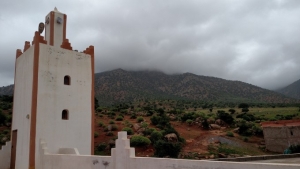
We crowded on the bus once again and left for dinner at Dar Si Hmad. A couple minutes after leaving the madrasa, we passed a herd of goats and one of them was in a tree! I FINALLY SAW A GOAT IN A TREE!!! We all got super excited and I freaked out so much, I forgot to take pictures. Also, there was just one and I didn’t want to miss the excitement because I was busy pulling out my camera.
As if that weren’t enough excitement for one day, there was a surprise waiting for us at dinner. When DSH hosts larger groups of students, they often employ a woman named Hadda to cook for the group. Hadda is a lovely woman who has been spoiling us all with her delicious meals every day at lunch time. Saturday night she prepared a very special meal: camel tagine. Yes, Sophie ate camel. It was tasty, although I’m glad it’s not eaten regularly, I’m not sure I could handle that. The camel tagine was served with a sweet couscous covered in Amlou, almond butter made with argan oil – a Moroccan specialty. I was a huge fan of the that.
After a long and exciting day, we all walked back to the hotel for showers and enjoyed some live music until we couldn’t stay awake any longer, and retired to our rooms.
Saturday morning started a little later than the previous day with yoga on the beach to stretch our sore muscles. Yoga was interrupted by three very large herds of sheep parading their way down the beach. Needless to say, all of us American girls were a little too obsessed with that to focus on yoga. Then we gathered for a big Moroccan breakfast of a variety of breads with tea. After a short tour of Ifni, we boarded the bus for the journey home. We got home mid-afternoon, exhausted and ready for a day of rest before the week started again.
